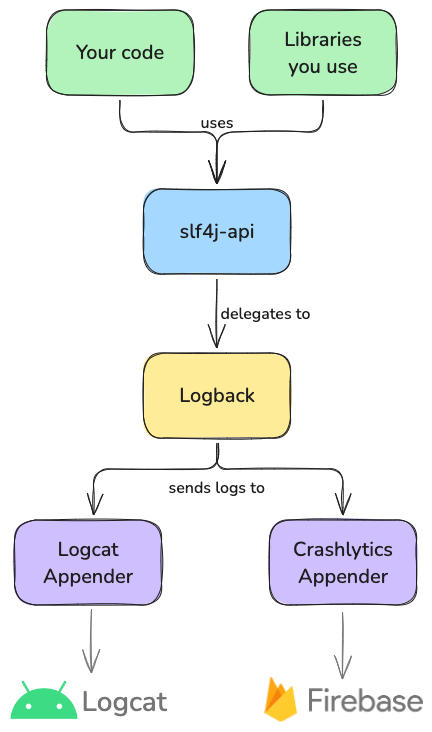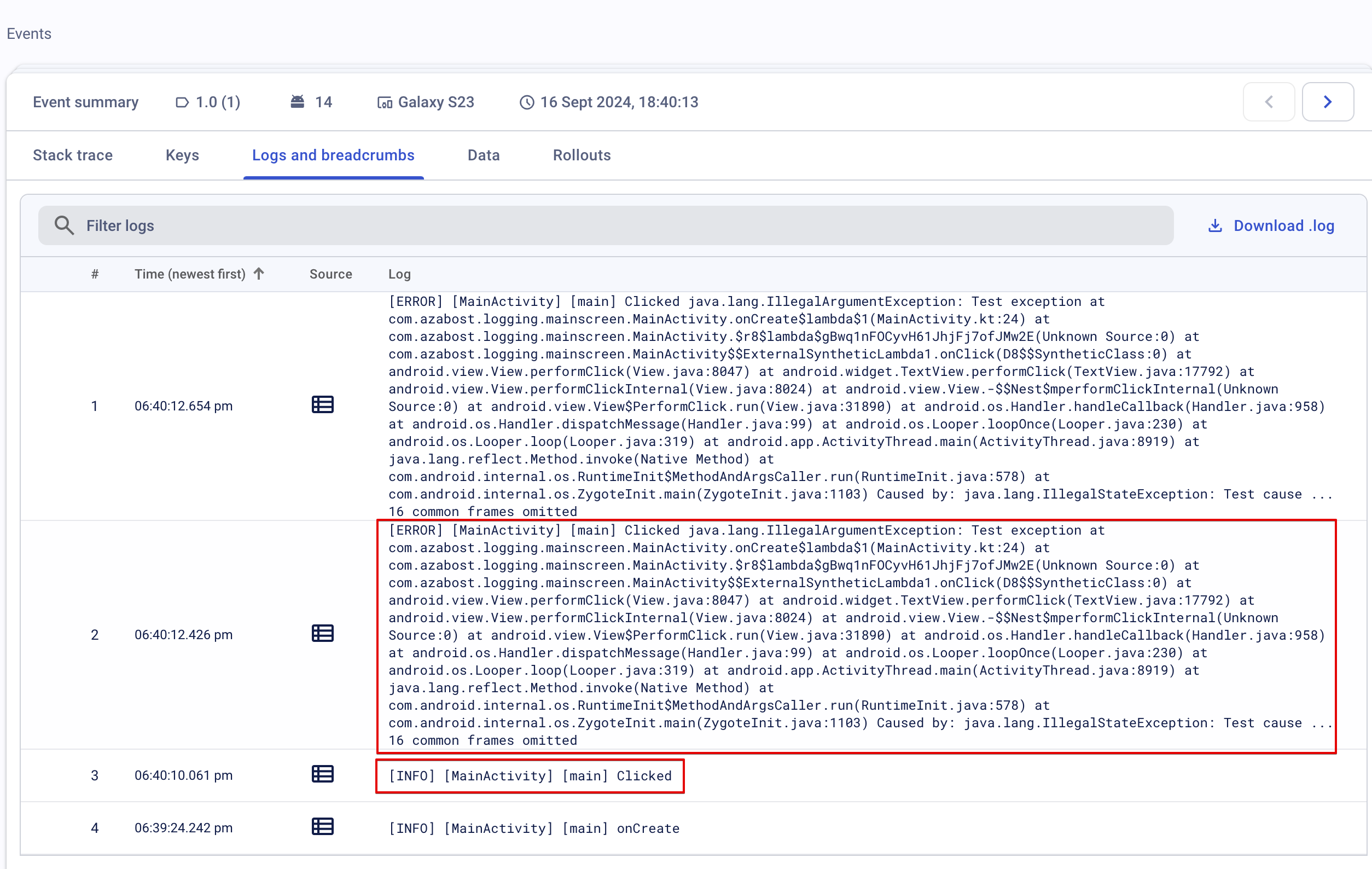Setting Up Logback Programmatically in Android
In my previous blog post, Choosing the Right Logging Library for Android, I discussed how I decided to use SLF4J alongside Logback for logging in Android apps. This post will take that foundation a step further by demonstrating how to configure Logback programmatically, ensuring that logs produced through the SLF4J API are properly sent to both Logcat and Firebase Crashlytics.
Why Not XML?
While it's common to configure Logback using XML files in backend applications, in an Android app, programmatic configuration offers a more streamlined approach. Unlike in a backend environment, where XML configuration can enable features like hot-reloading or modular configuration files for different environments (e.g., dev, test, and production), these benefits are less relevant in the context of Android apps due to their lifecycle and constraints of the mobile environment. Therefore, configuring Logback directly in code allows for greater flexibility (e.g. more dynamic configuration with feature toggles or user consent), fewer dependencies (hence smaller APK size), and simpler integration with Android-specific components like Logcat and Firebase Crashlytics.
The goal
To keep this post short and digestible, I will show you a very basic setup that would let you see the logs in Logcat and in Crashlytics (provided that your app is already integrated with Firebase).

If you're new to SLF4J and wonder how Logback is hidden behind SLF4J APIs, I recommend reading the SLF4J manual first.
First steps
To configure Logback programmatically, you need to access the LoggerContext by casting SLF4J's ILoggerFactory. Since Logback may be initialized with some defaults, you should stop() it before changing the configuration:
fun configureLogback() {
val loggerContext = LoggerFactory.getILoggerFactory() as LoggerContext
loggerContext.stop()
}
Appenders
To make Logback send logs to the actual destinations (like Logcat, Firebase, local files, you name it), you need Logback components called "appenders". There are a few appenders ready for reuse built into Logback, for example, a FileAppender can be used to write logs to local files. However, it should come as no surprise that Logback doesn't include the code necessary to send the logs to Android Logcat or to Firebase Crashlytics, because Logback is not an Android library and has no knowledge about Android APIs. (I assume you don't intend to use the Logback fork logback-android which I don't recommend for reasons mentioned in the previous blog post.)
You can read more about appenders in Logback documentation.
Let's see how easily we can integrate Logcat and Crashlytics logging into Logback.
Logcat
To create a custom appender, you should create a class that extends either AppenderBase or UnsynchronizedAppenderBase and override the abstract protected void append(E eventObject) method.
Here's a working example of such an appender:
class LogcatAppender(
private val messageLayout: Layout<ILoggingEvent>,
private val tagLayout: Layout<ILoggingEvent>,
) : UnsynchronizedAppenderBase<ILoggingEvent>() {
public override fun append(eventObject: ILoggingEvent) {
val logcatLevel = eventObject.level.toLogcatLevel() ?: return
val tag = tagLayout.doLayout(eventObject)
val message = messageLayout.doLayout(eventObject)
// Note: you may want to put Log.println behind an interface to make this class testable
Log.println(logcatLevel, tag, message)
}
}
fun Level.toLogcatLevel() =
when (levelInt) {
Level.ALL_INT, Level.TRACE_INT -> Log.VERBOSE
Level.DEBUG_INT -> Log.DEBUG
Level.INFO_INT -> Log.INFO
Level.WARN_INT -> Log.WARN
Level.ERROR_INT -> Log.ERROR
Level.OFF_INT -> null
else -> null
}
In the example above I also used another Logback component called Layout which I haven't explained yet. It's a measure to separate the message formatting from the appender's logic. I'm going to use Logback's PatternLayout to configure the formatting because it's very convenient and reduces the amount of code we need to write.
Now, let me show you how to integrate Logback with this new LogcatAppender.
First, let's add a function that creates LogcatAppender and the PatternLayouts:
fun createLogcatAppender(loggerContext: LoggerContext): Appender<ILoggingEvent> {
val tagLayout = PatternLayout().apply {
context = loggerContext
// %nopex prevents stacktraces from being printed in tags
pattern = "%logger{0}%nopex"
start()
}
val messageLayout = PatternLayout().apply {
context = loggerContext
pattern = "[%thread] %msg%n%exception"
start()
}
return LogcatAppender(tagLayout = tagLayout, messageLayout = messageLayout).apply {
context = loggerContext
start()
}
}
The tagLayout above is used to format the tag passed to Logcat, which by convention consists of a class name. While %logger would print a fully qualified class name, %logger{0} will only print the simple name.
messageLayout will print the thread name in square brackets followed by the message and the associated exception's stacktrace (if any) after a line separator.
Examine Logback documentation for more patterns. You can also write your own patterns, but I won't cover it in this post.
I added %nopex to the tagLayout because PatternLayout has a nasty feature that implicitly adds the stacktrace of the associated exception to its formatting result (examine %exception documentation for more details). Obviously, we don't want a stacktrace in Logcat's tag. Alternatively, you could subclass PatternLayout to disable this behavior and then remove %nopex from the pattern:
class NoImplicitExceptionsPatternLayout : PatternLayout() {
init {
setPostCompileProcessor(null)
}
}
Now, go back to the initial code where you obtained a LoggerContext. Use it to get the "root" logger and attach the new appender to it like this:
val logcatAppender = createLogcatAppender(loggerContext)
val rootLogger = loggerContext.getLogger(Logger.ROOT_LOGGER_NAME)
rootLogger.addAppender(logcatAppender)
Since Logback loggers are hierarchical, the appenders added to the root logger will be automatically inherited by all loggers e.g. LoggerFactory.getLogger(Whatever::class.java). In short, it means that all logs will be forwarded to LogcatAppender.
Crashlytics
Similarly, you can create a CrashlyticsAppender:
class CrashlyticsAppender(
private val layout: Layout<ILoggingEvent>,
private val logAllExceptions: Boolean,
) : AppenderBase<ILoggingEvent>() {
override fun append(eventObject: ILoggingEvent) {
// Note: you may want to put Firebase.crashlytics.log behind an interface to make this class testable
Firebase.crashlytics.log(layout.doLayout(eventObject))
recordExceptionIfRequested(eventObject)
}
private fun recordExceptionIfRequested(eventObject: ILoggingEvent) {
val throwable = (eventObject.throwableProxy as? ThrowableProxy)?.throwable
if (logAllExceptions && throwable != null) {
Firebase.crashlytics.recordException(throwable)
}
}
}
The example above has an additional feature of reporting "non-fatal" exceptions to Crashlytics whenever there is a throwable associated with a log event. You can delete the logAllExceptions flag and recordExceptionIfRequested if you don't need it.
Now, you can create the appender with the desired message pattern:
fun createCrashlyticsAppender(loggerContext: LoggerContext): Appender<ILoggingEvent> {
val layout = PatternLayout().apply {
context = loggerContext
pattern = "[%level] [%logger{0}] [%thread] %msg%n%exception"
start()
}
return CrashlyticsAppender(layout = layout, logAllExceptions = true).apply {
context = loggerContext
start()
}
}
And finally add it to the root logger:
val crashlyticsAppender = createCrashlyticsAppender(loggerContext)
rootLogger.addAppender(crashlyticsAppender)
Results
Now, to test this setup, you only need to call configureLogback() somewhere (for example, in your Application.onCreate()) and add a few SLF4J usages such as:
val logger = LoggerFactory.getLogger(MainActivity::class.java)
// Somewhere else:
logger.info("Clicked")
// Somewhere else:
logger.error(
"Clicked",
IllegalArgumentException("Test exception", IllegalStateException("Test cause"))
)
You should see the logs in Logcat and, once the logs get sent to Firebase (e.g. due to a crash), in Crashlytics.
Here are a few screenshots from my demo app where I tested this setup:



You can find the complete code here.
I may add more examples to that repo in the future, so make sure to check out the basic-logcat-crashlytics branch that will contain the code related to this post only).
Addendum
The appenders' code above is incompatible with Logback's XML configuration feature. For example, I'm pretty sure the appenders should have no-argument constructors and public properties as shown in this article. Since I don't intend to configure Logback via XML in Android apps, I decided not to dwell on that topic in this blog post to keep the code simpler.
Copyright notice:
The Android robot is reproduced or modified from work created and shared by Google and used according to terms described in the Creative Commons 3.0 Attribution License.
